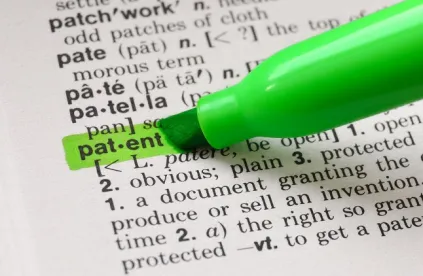Holding
In Chemours Company FC, LLC v. Daikin Industries, Ltd., a CAFC panel reversed an obviousness determination by the PTAB (“Board”), holding that the Board improperly found motivation to modify a prior art reference, where the “inventive concept’ of the prior art reference taught away from that modification.
Background
The patents at issue in Chemours related to polymers with unique properties such that they can be formed at high extrusion speeds while still producing a high-quality coating on communication cables. Id. at *4. In particular, the claims recited that the polymers have “a high melt flow rate of about 30±3 g/10 min,” which the patent taught enabled the polymer to be coated at higher speeds.
The Board found the claims to have been obvious over a single prior art reference, which taught each of the elements of the claimed polymer except the particular melt flow rate of 30±3 g/10 min. Instead of focusing on melt flow rate to achieve higher coat speeds, the “inventive concept” of the prior art reference was found to focus on maintaining a “narrow molecular weight distribution” of the polymer. With respect to melt flow rate, the prior art reference disclosed only that its polymers may have melt flow rates of “15 g/10 min or greater” in the specification and included an example with a melt flow rate of 24 g/10 min. Id. at *7.
Importantly, the Board found that increasing the melt flow rate of the prior art’s example to within the claimed range would require broadening the molecular weight distribution of the polymer, which the Board acknowledged was contrary to the prior art’s inventive concept of a narrow distribution. Nevertheless, the Board held that it would have been obvious to have modified the prior art reference to increase the melt flow rate because it found that other evidence of record taught increasing the melt flow rate as a means for achieving higher coating speeds. Id. at *4. The Board found that the “narrowing molecular weight distribution” teaching of the cited prior art would not have prevented the skilled artisan from considering other known techniques for increasing speed, such as increasing the melt flow rate. Id. at *8.
Federal Circuit Decision
The CAFC reversed, 2-1 on the issue of obviousness. A Board’s determination of obviousness is a question of law that is based on underlying findings of fact, which are reviewed for substantial evidence. Such underlying questions of fact include what the prior art teaches, whether a person of ordinary skill in the art would have been motivated to combine references and whether a reference teaches away from the claimed invention. Id. at *5.
The CAFC found that the prior art reference “appears to teach away from broadening molecular weight distribution,” including specifically teaching away from numerous examples of processing techniques used to increase melt flow rate due to the risk of those techniques broadening the molecular weight distribution. Id. at *10. The CAFC noted that, while the Board may rely on other prior art to inform itself of the state of the art, the cited prior art reference was the sole reference in the Board’s rejection and the other teachings relied upon by the Board to support motivation were from references that were not concerned with the particular problems the cited prior art reference sought to solve. Id. at *9. The CAFC thus concluded that the Board failed to articulate a satisfactory explanation based on substantial evidence for why a skilled artisan would have been motivated to, and reasonably expected to be able to, increase the melt flow rate of the prior art polymer to the claimed range when all known methods for doing so would necessarily involve altering the prior art’s “inventive concept” by broadening molecular weight distribution. Id. at *10-11.
Judge Dyke dissented, arguing that “[t]he majority’s approach impermissibly expands the teaching away doctrine such that it encompasses a reference’s mere preference for a particular alternative.” Dissent at *3. While agreeing that it is true that the prior art reference’s inventive concept was use of a narrow molecular weight distribution to achieve high coating speeds, the prior art reference also acknowledged the “feasibility” of prior broad molecular weight distributions. Id. In Judge Dyke’s opinion, the teaching of a “better” embodiment does not constitute a “teaching away” from alternative “feasible” solutions. Id. Judge Dyke was also persuaded that the prior art reference did not clearly define what was meant by a “narrow molecular weight distribution” and asserted that there was no support in the record that increasing the melt flow rate of the prior art’s example to within the claimed range would result in a molecular weight distribution that was no longer “narrow.” Id. at *4.
Take Aways
If faced with a rejection from an examiner, try to show the prior art relied on would have led one of ordinary skill in the art in a different direction than the claimed invention or would have meant that one of ordinary skill in the art would not have reasonably expected success to proceed on the path resulting in the claimed invention.
The state of the art at the time of the effective filing date of the invention may have pointed researchers in a different direction than that followed by the inventor. The Federal Circuit has repeatedly recognized that proceeding contrary to the accepted wisdom in the art represents “strong evidence of unobviousness.” See, e.g., In re Hedges, 783 F.2d 1038, 1041 (Fed. Cir. 1986); W.L. Gore & Assocs., Inc. v. Garlock, Inc., 721 F.2d 1540, 1552 (Fed. Cir. 1983).
Practitioners are cautioned, however, that “teaching away” can be a high bar and is usually not met by mere disclosure of alternatives or even a description that some teaching is somewhat inferior. MPEP § 2143(E) and §2143.01(I); In re Gurley, 27 F.3d 551 (Fed. Cir. 1994); In re Fulton, 391 F.3d 1195, 1201 (Fed. Cir. 2004); Galderma Labs. v. Tolmar, Inc., 737 F.3d 731, 738 (Fed. Cir. 2013); Bayer Pharma AG v. Watson Labs., Inc., 874 F.3d 1316, 1327 (Fed. Cir. 2017).
Citing In re Gurley and In re Fulton, the Federal Circuit reiterated the proper standard for teaching away as follows: a reference will teach away when it suggests that the developments flowing from its disclosures are unlikely, reasonably, to produce the objective of the applicant’s invention. A statement that a particular combination is not a preferred embodiment does not teach away absent clear discouragement of that combination. See Syntex (U.S.A.) LLC v. Apotex, Inc., 407 F.3d 1371, 1380 (Fed. Cir. 2005).
Nevertheless, the Chemours decision highlights that “teaching away” can be an effective argument for patentees to attack an assertion of a motivation to modify or combine a primary reference, particularly where the primary reference does not just offer an alternative or “preferred” solution, but expressly cautions against the very solution proposed as the modification.
Stacy Lewis is a Law Clerk at Finnegan.




 />i
/>i

